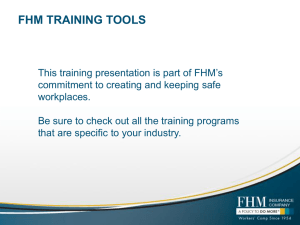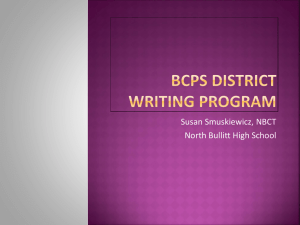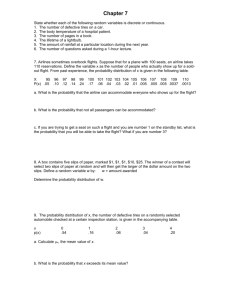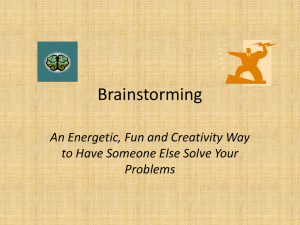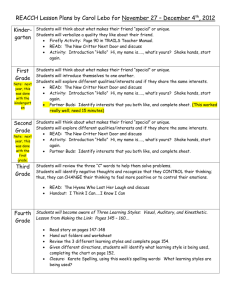Critters - Rewarding Positive Behavior
advertisement
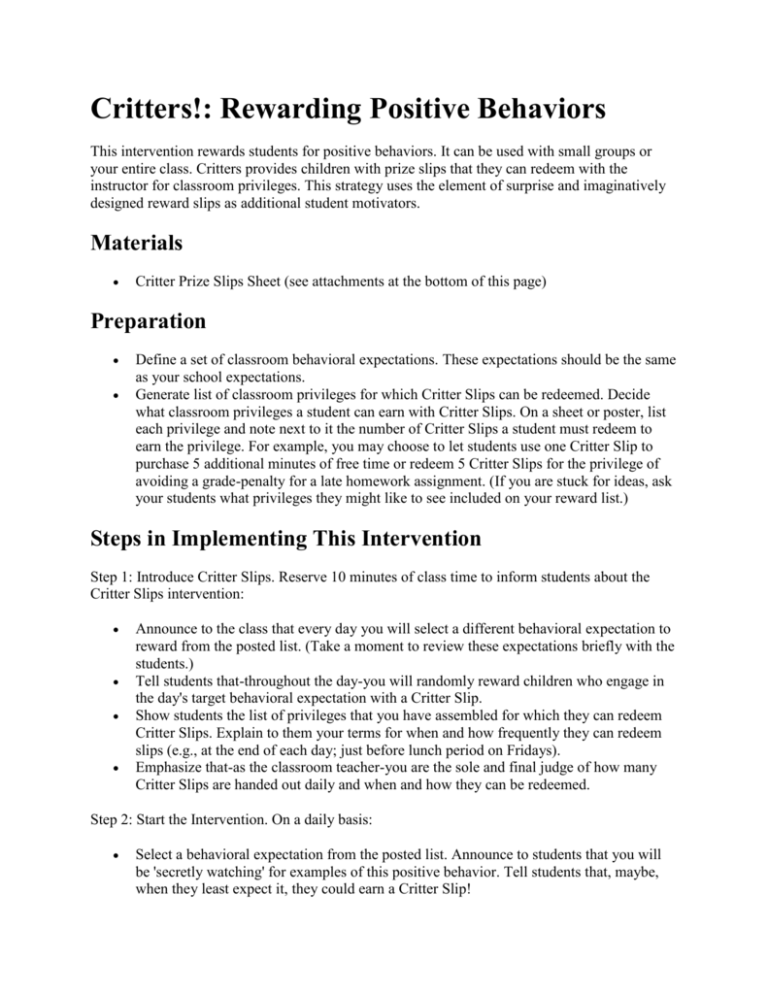
Critters!: Rewarding Positive Behaviors This intervention rewards students for positive behaviors. It can be used with small groups or your entire class. Critters provides children with prize slips that they can redeem with the instructor for classroom privileges. This strategy uses the element of surprise and imaginatively designed reward slips as additional student motivators. Materials Critter Prize Slips Sheet (see attachments at the bottom of this page) Preparation Define a set of classroom behavioral expectations. These expectations should be the same as your school expectations. Generate list of classroom privileges for which Critter Slips can be redeemed. Decide what classroom privileges a student can earn with Critter Slips. On a sheet or poster, list each privilege and note next to it the number of Critter Slips a student must redeem to earn the privilege. For example, you may choose to let students use one Critter Slip to purchase 5 additional minutes of free time or redeem 5 Critter Slips for the privilege of avoiding a grade-penalty for a late homework assignment. (If you are stuck for ideas, ask your students what privileges they might like to see included on your reward list.) Steps in Implementing This Intervention Step 1: Introduce Critter Slips. Reserve 10 minutes of class time to inform students about the Critter Slips intervention: Announce to the class that every day you will select a different behavioral expectation to reward from the posted list. (Take a moment to review these expectations briefly with the students.) Tell students that-throughout the day-you will randomly reward children who engage in the day's target behavioral expectation with a Critter Slip. Show students the list of privileges that you have assembled for which they can redeem Critter Slips. Explain to them your terms for when and how frequently they can redeem slips (e.g., at the end of each day; just before lunch period on Fridays). Emphasize that-as the classroom teacher-you are the sole and final judge of how many Critter Slips are handed out daily and when and how they can be redeemed. Step 2: Start the Intervention. On a daily basis: Select a behavioral expectation from the posted list. Announce to students that you will be 'secretly watching' for examples of this positive behavior. Tell students that, maybe, when they least expect it, they could earn a Critter Slip! Put a predetermined number (e.g., 10) of Critter Slips into your pocket. During the day, make a point to hand out all of the slips to students displaying the target behavior. Be impartial: Avoid favoring any group of students when giving out slips! Each student receiving a slip should write his or her name on it and store it in a safe place until he or she is ready to redeem it. At whatever time interval you have set with the class, give students the chance to redeem their Critter Slips for privileges or rewards. (Some teachers are comfortable letting students redeem slips whenever they choose while other instructors prefer the structure of a pre-set ' slips redemption time'.) Step 3: Fade Critter Slips Intervention. Once you have found the Critter Slips program to be effective and stable for several weeks, you can begin to 'fade' it. Begin by handing out successively fewer slips each day. (For example, over a three-week period, you might gradually reduce the number of slips rewarded to the class from 10 to 4 per day.) Next, you can randomly pick days (e.g., once per week) when the intervention is not used. Slowly taper the program off until you are implementing it only occasionally (e.g., once every two-three weeks). If student behaviors begin to worsen during the fading period, put the program back into effect at full strength until behaviors improve. Then repeat the fading process, this time at a somewhat slower pace. Troubleshooting Students hoard their slips instead of redeeming them. In general, don't worry too much if children in your room refuse to spend the reward slips that they have collected. So long as the slips themselves motivate these students to model good behaviors, your intervention will probably achieve its desired effect. Perhaps you are concerned, though, that students are hoarding slips in order to cash them in eventually for an unusually large prize that might be difficult to accommodate (e.g., 45 minutes of continuous free time). To prevent such an occurrence, you might place modest restrictions on students' redeeming of slips. For example, you might announce that students can redeem no more than 10 slips on any one day. Students argue about the terms for redeeming reward slips. Generally, you can expect Critter Slips to go off without a hitch as a classroom behavioral strategy. Of course, you should not be surprised if initially students engage in a bit of 'testing' behavior--pleading, wheedling, negotiating, and complaining--when they redeem reward slips. If you are firm, consistent, and fair in implementing the program, this testing behavior should vanish quickly. Once in a while, though, you may encounter a chronically oppositional student who regularly argues with you about the conditions for cashing in his or her reward slips. In this case, you can inform the student that you will fine him or her a reward slip for each time that he or she argues with you. References Thanks to Kathleen Baker, a speech language pathologist from Central New York, for positive intervention ideas included in this strategy! Jim's Hints Have a 'Mystery Behavior Day'. Tell students at the start of the day that you will be handing out Critter Slips as usual, but that you are keeping secret the positive behavior that you are rewarding. When handing out slips, say to the receiving students something like: "Nice job. Here is a Critter Slip. Think about why you received it!". At the end of the day, ask students who had received Critter Slips to guess the positive behavior that you had selected as the theme for that day. Customize Reward Slips to Support Curriculum. You may want to create your own customized reward slips to link them thematically to the curriculum that you are teaching. If you are presenting a unit on African wildlife, for example, you might make up slips that depict representative animals from the savannah ecosystem. For a unit on American presidents, you could hand out reward slips featuring the faces and names of lesser-known Chief Executives to help children better to remember them. Alter the Reward Slips for Older Students. The Critter Slips program is suitable for older students as well as for younger children. Since 'cute' Critter Slips may put off middle and high school students, though, you can replace them with reward slips that resemble currency. Some inventive teachers even go so far as to create 'classroom bucks', fake dollar bills that display their face and name. Older students collect these 'dollars' as avidly as smaller children seek Critter Slips!

